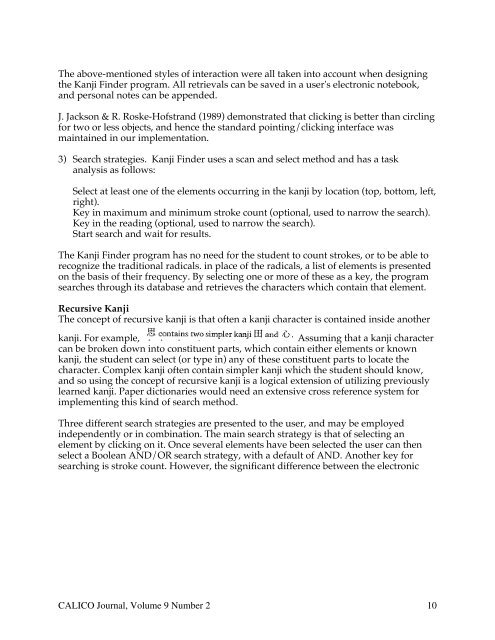Kanji Retrieval by Recursive Location of Elements Using HyperCard
Kanji Retrieval by Recursive Location of Elements Using HyperCard
Kanji Retrieval by Recursive Location of Elements Using HyperCard
Create successful ePaper yourself
Turn your PDF publications into a flip-book with our unique Google optimized e-Paper software.
The above-mentioned styles <strong>of</strong> interaction were all taken into account when designing<br />
the <strong>Kanji</strong> Finder program. All retrievals can be saved in a user's electronic notebook,<br />
and personal notes can be appended.<br />
J. Jackson & R. Roske-H<strong>of</strong>strand (1989) demonstrated that clicking is better than circling<br />
for two or less objects, and hence the standard pointing/clicking interface was<br />
maintained in our implementation.<br />
3) Search strategies. <strong>Kanji</strong> Finder uses a scan and select method and has a task<br />
analysis as follows:<br />
Select at least one <strong>of</strong> the elements occurring in the kanji <strong>by</strong> location (top, bottom, left,<br />
right).<br />
Key in maximum and minimum stroke count (optional, used to narrow the search).<br />
Key in the reading (optional, used to narrow the search).<br />
Start search and wait for results.<br />
The <strong>Kanji</strong> Finder program has no need for the student to count strokes, or to be able to<br />
recognize the traditional radicals. in place <strong>of</strong> the radicals, a list <strong>of</strong> elements is presented<br />
on the basis <strong>of</strong> their frequency. By selecting one or more <strong>of</strong> these as a key, the program<br />
searches through its database and retrieves the characters which contain that element.<br />
<strong>Recursive</strong> <strong>Kanji</strong><br />
The concept <strong>of</strong> recursive kanji is that <strong>of</strong>ten a kanji character is contained inside another<br />
kanji. For example, Assuming that a kanji character<br />
can be broken down into constituent parts, which contain either elements or known<br />
kanji, the student can select (or type in) any <strong>of</strong> these constituent parts to locate the<br />
character. Complex kanji <strong>of</strong>ten contain simpler kanji which the student should know,<br />
and so using the concept <strong>of</strong> recursive kanji is a logical extension <strong>of</strong> utilizing previously<br />
learned kanji. Paper dictionaries would need an extensive cross reference system for<br />
implementing this kind <strong>of</strong> search method.<br />
Three different search strategies are presented to the user, and may be employed<br />
independently or in combination. The main search strategy is that <strong>of</strong> selecting an<br />
element <strong>by</strong> clicking on it. Once several elements have been selected the user can then<br />
select a Boolean AND/OR search strategy, with a default <strong>of</strong> AND. Another key for<br />
searching is stroke count. However, the significant difference between the electronic<br />
CALICO Journal, Volume 9 Number 2 10
















